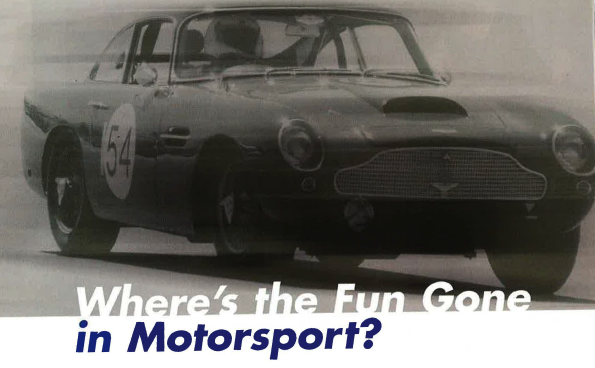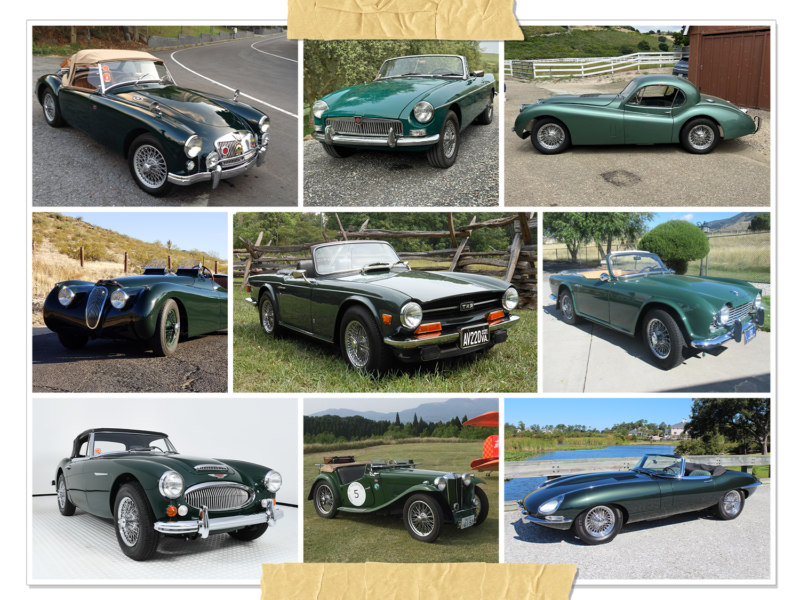By Paul Richardson
Things have changed big time in motor racing since the ’50s and ’60s, and many questions are regularly asked to the effect of, “Where’s the fun gone in motorsport?” or “Why are there so many examples of bad sportsmanship in motor racing these days?”
In my opinion, it’s a question of character (or the lack of it), and it has nothing to do with money. The thing that disturbs me deeply in Formula-1 and other formulas are regular examples or appalling sportsmanship where drivers deliberately and blatantly drive into “fellow” competitors to put them out of contention for a race—or indeed a world championship win.
This practice is most blatantly obvious in saloon car racing—which in the U.K. often carries the tag “destruction derby” racing.
Motor racing has always been cut and thrust, but in the ’50s and ’60s there was, first and foremost, a camaraderie in motorsport which was a pleasure to be part of, and examples of true sportsmanship abounded aplenty.
One of the finest examples I came across concerned Lotus F-1 driver Trevor Taylor, way back in Formula Junior days circa 1960. Trev and the late and great F-1 world champion “gentleman” Jim Clarke, who both started their racing careers driving TRs, had an unassailable lead in the Formula Junior World Championship, and, come the last race at Silverstone, they were tying for first place. Jim, however, had another driving commitment that day, and could not drive in the final race—leaving Trev to “clean up.” Trev needed only one more point to wrest the championship from Jim, which he knew would be a walkover without Jim in the race. Trev finished third in the very wet final race (which he would have won were it not for severely locking rear brakes) and technically became world FJ champion.
But after the race, he went straight to the organizer and pointed out that, as Jim Clarke was not in the race to contest the championship, the result was unfair, and insisted that he and Jim should share the championship. The organizers did not like this idea one little bit, and decided that a definite winner should be found by virtue of finding the driver with the best overall performance in all the championship races. The calculation was done, and it was found that both drivers had exactly the same number of 1st, 2nd, and 3rd places, and exactly the same number of pole positions, etc. Thus, on Trev’s insistence, he shared the world championship with Jim Clarke. Would this happen today? I think not.
Motor racing in the ’50s and ’60s was a veritable tapestry of truly colorful characters, including friend and fellow British Motoring columnist John Sprinzel. John was one of the greats of the saloon car and rally era of the ’50s and ’60s, and many’s the time I saw him dicing with the late Graham Hill in Austin A30/35s—their duels often contested whilst sandwiched between a couple of high-powered Jags. Interestingly, John said of that era, “I don’t ever remember any incident in my career where a driver deliberately drove into anyone, and throughout all my years of saloon car racing I never had so much as a lick of paint on any of my cars from another competitor.”
As readers will know, John raced anything from “Sprinzel” Sprites and A35s to Ford Galaxie 500s—and in an era when the cut and thrust of saloon car racing was sharpened by the fact that the Grand Prix drivers of the day also raced in saloon car events before a Grand Prix.
Drivers and works teams naturally took racing as seriously as they do these days. However, the wonderful sport of motor racing in those far-off days was definitely more fun. After a race, the first stop for drivers and mechanics was usually the paddock bar—rather than being held prisoner in five-star hospitality units. I always find it amusing observing grand prix drivers today every time a TV camera is pointed at them. They instantly duck away, reach for the dreaded “sponsors hat,” and re-appear in shot with a hat with a peak a foot long and a similarly overemphasized smile—or not.
One of the greatest characters in sports car racing was the late Ninian Sanderson, who won Le Mans in 1956 and finished second the following year in Ecurie Ecosse D-Type Jaguars. “Nin” was a lifelong friend of my late father Ken and drove in Ken’s first works Le Mans Triumph TR2 team in 1955, and later in the “twin cam” team. He was a great driver, an even greater human being, and he also enjoyed a pint or two with the boys—whilst always remaining the untiring master of the practical joke.
One such instance involved a hotel restaurant trout tank. Ninian decided the fish in the tank were too crowded. The next morning, hotel guests were complaining about shoals of fish seen darting about in the hotel swimming pool!
In the 1955 Le Mans race, my father Ken always loved relating the time when he noticed Ninian in the distance in his rearview mirror driving like hell and closing fast, apparently after a recent pit stop. Later, about halfway down the Mulsanne straight, Ken noticed Ninian flashing his lights furiously behind him and, thinking something was wrong, eased up to allow him to draw comfortably alongside. As Ken looked across, Ninian shouted, “Got any cigarettes on you, Ken? I’m dying for a smoke!”
From my own experience, being a racing mechanic in those halcyon days of a bygone era was hard work—very hard work, but those days also hold some of the happiest memories of my life. Driving to and from European races in racing transporters was a time for a laugh or two with fellow mechanics and drivers. Yes, in those days, drivers would often choose to travel with the “mecs” to races. Part of the fun were the breaks on those journeys, where essential equipment for any self-respecting racing team was a primus stove and, more often than not, a barrel of English beer. Those stops, whilst brewing up a cup of “rosy tea” and enjoying bacon, eggs, and a fried slice cooked in a roadside country pull-in, were wonderful, fun times where camaraderie, fun, and a sense of fair play was part and parcel of the wonderful sport of motor racing—and drivers had a sense of humor.
I remember in the early ’60s, at the British Grand Prix at Silverstone, there were two grand prix races. The main event, of course, was for F-1 cars, and the other was for Morris Minis. BMC, for a publicity stunt, provided every grand prix driver with a Mini for a special Mini race before the grand prix. About two dozen Minis lined up on the grid, and when the flag dropped, all the cars screamed off in REVERSE back round Woodcote corner. After temporarily confusing spectators and officials alike, the herd of Minis then shot off in the right direction, in a cloud of tire smoke, towards Copse corner—to tumultuous and appreciative applause. This was one of the most entertaining saloon car races I’ve ever seen, with Minis dicing five abreast round the flat-out Woodcote corner. If I remember correctly, it was that great character and F-1 driver Innes Ireland who was the main instigator of the reversing Minis.
Staying awake when extremely tired was part of the job of a racing mechanic, and having a laugh was an essential part of keeping slumber at bay, as it kept the blood moving. One of my favorite “wakey-wakeys” was what I called “the Grand Prix alarm call.” There were three of us in the cab, including the aforementioned Trevor Taylor, and we were on our way to a race in Sweden, whilst still recovering from the prize presentation and gala dinner the previous evening at a circuit called Coxide in Belgium, where Trev had just won a F5000 race.
Trev, and my fellow mechanic Cedric, were fast asleep beside me and snoring like a couple of water buffaloes. As I came to a long, straight stretch of country road, with no traffic in front or behind, it was time to deliver the alarm call. I gently leant forward and positioned my upper torso flat on top of the steering wheel (which was almost horizontal), with my head flat to one side on the wheel rim—so positioned that I could still see the road.
Satisfied that my posture resembled complete collapse at the wheel—with my left arm now hanging down and free swinging, I felt for the horn switch (a conveniently placed stick switch just below the steering wheelrim) with the second finger of my “steering hand” and pressed it—all whilst gently steering the transporter to the wrong side of the road and heading for a ditch. My pals awoke instantly to the sound of the continuing horn blast to be met with the sight of a collapsed driver at the wheel. The resultant crash of feet on the floorboards and the tenor of the breath-gulping, panicked screams were, of course, suitably orchestrated with a thunderous clap of thoroughly disgraceful swear words. As I gently moved back to my normal driving position, with a cigarette still in my mouth, we all burst into uncontrollable laughter at the heart-bursting adrenaline rush I’d fired through the tired bodies of my pals—and the fact that Trev had been dribbling on his shirt and his hair was standing up vertically on one side where he’d been sleeping on it.








'Where’s the Fun Gone in Motorsport?' has no comments
Be the first to comment this post!